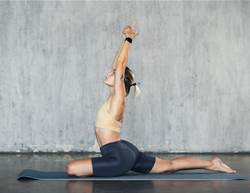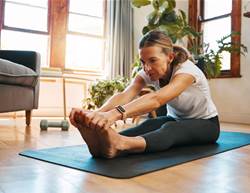Whether you sit most of your day or are a fitness fanatic, we should all stretch on a regular basis.
The American College of Sport (ACSM) Medicine recommends that we stretch every day. Aim to stretch each of the major muscle-tendon groups—neck, shoulders, chest, trunk, lower back, hips, legs, and ankles.
The ACSM says we should hold static stretches for 10–30s, and older people should hold stretches for 30–60s, as this may improve flexibility even more. And yes, yoga and tai chi count as part of your stretching regimen.
The Australian Institute of Fitness says even a few minutes of stretching a day can unlock benefits.
But what about stretching before exercising – is it actually worth it?
Here are some of the benefits of stretching to warm up.
1. It improves motion
“Warming up preps your muscles for exercise and physical activity,” says exercise physiologist David Watts from Sydney Sports and Exercise Physiology. “It increases muscular elasticity (improving your joints’ range of motion) and coordination.”
Psychologically, it also readies you for whatever comes next, just like putting on your gym gear does. Active heating – warming your muscles through movement – increases body temperature, blood flow and muscular elasticity. Passive heating via heat pads or hot water bottles doesn’t offer the same benefit, says Watts. And warming up doesn’t need any extra equipment, so get warm for the win.
2. Blood flow increases
At rest, your muscles receive about 20% of your blood flow, with most directed to organs. During all-out exercise, more than 80% of your blood can be aimed at working muscles.
“During a warm-up, your core body temperature rises, causing your blood vessels to widen and supply more oxygenated blood and nutrients to your muscles,” explains Watts.
Go in cold and your body has to quickly make circulatory and metabolic adjustments. Research also suggests active warm-ups can lead to making your body’s metabolic processes more efficient, he says. That could mean less fatigue-inducing muscle acidity.
3. It preps your heart
You wouldn’t inflict high-BPM (beats per minute) music on your waking brain, but your body is sensitive to BPM, too. So, going from 60 beats per minute (resting heart rate) to 120 is a big jump in workload for your heart.
“A gradual warm-up allows your heart to steadily increase heart rate and blood pressure to prepare you for exercise in the most efficient way,” says Watts.
4. Muscle flexibility grows
Dynamic stretches involve a joint moving and a contraction of the surrounding muscle tissue. (Think lowering into a squat and returning to the starting position.)
They’re a warm-up winner for more intense exercises requiring specific movements, such as box jumps, and can improve the range of motion in your joints and your muscle performance.
Static stretches, where a joint is stationary and the surrounding muscle tissues are relaxed (think sitting and stretching out your hamstring), are great for flexibility.
“Dynamic stretching is good for warming up because it increases blood flow and movement coordination, while static stretching may be used in a rehab setting, for example, before moving on to getting stronger for a proper exercise program,” says Watts.
5. You feel amazing!
Body warm? Now let’s work on your mind. A happy side effect of warming up is a confidence boost.
“You’ll feel more motivated if you warm up properly,” says Watts, “not to mention that the endorphins that movement releases will reduce your stress and anxiety levels.”
Making warming up a part of your exercise routine also helps you to form and maintain healthy habits by getting you in the right ‘headspace’ for training.
Aim for about 5 to 10 minutes of stretching before the real work begins, suggests Watts.
There’s more to it than a warm up
While stretching can prep you for a workout, there’s more to it than that. Experts recommend stretching daily, even if you can’t do your workout that day. This may benefit both your physical and mental health.
“Daily stretching has been shown to increase range of motion, flexibility, and blood flow to muscles; it also reduces stress,” says Bryan Adams-Colon from the University of Colorado.
Stretching can even help back pain and improve posture.
Try these stretches for lower back pain or add these full body stretches to your daily routine.










